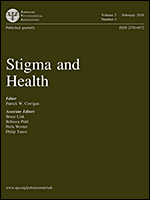
JAMES, RYAN – Measuring dimensions of HIV-related stigma among college students
James, T. G., Gebru, N. M., Ryan, S. J., & Cheong, J.
Article first published online: 25 JUN 2020 Stigma and Health
DOI: 10.1037/sah0000266
ABSTRACT: HIV-related stigma remains a critical barrier to achieving national public health objectives including reducing HIV transmissions and retaining people living with HIV (PLHIV) in care. Adolescents and emerging adults are particularly vulnerable to HIV-related stigma and HIV transmission and, thus, are a priority population with regard to reducing stigma and increasing health care engagement. In order to reduce stigma, a better understanding of the multidimensional nature of HIV-related stigma is needed. The Stigmatizing Attitudes Toward People Living with HIV/AIDS Scale (SAT-PLWHA-S) is a measure of HIV-related stigma developed in Canada. The current investigation sought to assess the validity and dimensionality of a revised SAT-PLAWHA-S in young adults and in the United States. A revised SAT-PLWHA-S was completed by 2,686 college students in the southeastern United States. Confirmatory factor analysis indicated that the revised SAT-PLWHA-S measures a 6-factor structure consisting of Concerns of Occasional Encounters, Avoidance of Personal Contact, Responsibility and Blame, Liberalism, Nondiscrimination, and Social Policy. Overall, participants in our sample had low HIV-related stigma (M = 3.11; range 1–4, higher scores indicate less stigma). Scores demonstrated discriminant and concomitant validity with demographic characteristics, sexual behaviors, HIV testing history, and knowing PLHIV. We observed more stigmatizing attitudes regarding social policy, underscoring the need for public health practitioners and researchers to reduce HIV-related stigma related to criminalization and disclosure policies.
Read the full publication at Stigma and Health